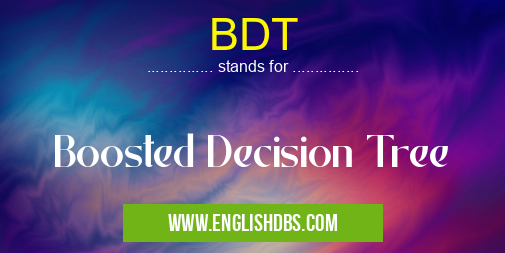What does BDT mean in UNCLASSIFIED
A Boosted Decision Tree (BDT) is an ensemble learning technique that combines multiple decision trees to create a larger, more powerful model. BDTs are used in data analysis and machine learning applications where the goal is to accurately identify patterns or classifications among input data. This type of algorithm has been around for decades, but has recently gained popularity due to its increased accuracy and effectiveness on real-world datasets.

BDT meaning in Unclassified in Miscellaneous
BDT mostly used in an acronym Unclassified in Category Miscellaneous that means Boosted Decision Tree
Shorthand: BDT,
Full Form: Boosted Decision Tree
For more information of "Boosted Decision Tree", see the section below.
Essential Questions and Answers on Boosted Decision Tree in "MISCELLANEOUS»UNFILED"
What is a Boosted Decision Tree (BDT)?
What advantages does using a BDT have compared to other methods?
BDTs provide several advantages over other models such as logistic regression, random forests, and support vector machines. Additionally, BDTs can handle a large number of features and data points without sacrificing performance. The use of multiple decision trees leads to better generalization performance – meaning, it can accurately identify patterns even with previously unseen data. Lastly, they are relatively insensitive to outliers or noisy data points in comparison with other algorithms.
How do BDTs work?
Often referred to as “stacking” or “gradient boosting” models, BDTs use a tree-based ensemble approach. Each tree within the ensemble is trained independently on different subsets of the data while also taking into account the errors made in previous predictions from the model. The outcome of each tree is then combined into an overall prediction result which represents the output of the entire boosted decision tree algorithm.
How reliable are results generated through BDTs?
Boosted decision trees have proven themselves very reliable when it comes to making accurate predictions on datasets from various domains – especially those with complex relationships between features and labels. Resulting models may vary in terms of accuracy depending on how much training data was provided along with other factors such as hyperparameter tuning. However, overall results tend to be quite consistent when using well-processed datasets from standard sources.
How can I implement a BTD model?
There are several open source libraries available for implementing a BTD model on any platform or language you may choose - some examples include XGBoost and LightGBM. In addition, cloud computing solutions offer prebuilt frameworks such as Amazon’s Sagemaker which simplifies the process significantly by providing dataset processing functions as well as optimized parameter settings for model deployment.
What types of problems are best suited for using a BTD?
Boosted decision tree algorithms are particularly well suited for classification tasks involving complex relationships between features - e.g pattern recognition problems like computer vision or natural language processing applications. They can also be applied quite effectively in some regression tasks where predicting continuous values instead of categories is desired such as stock market forecasting or energy demand prediction systems.
Can I use my own custom parameters when training a BTD?
Yes – most libraries/frameworks that support boosting algorithms allow users to set their own custom parameters depending on their goals and preferences. This includes adjusting how weakly correlated parameters should be considered during training, setting minimum leaf node samples thresholds and choosing between loss functions suitable for either regression or classification tasks.
Are there any limitations associated with using boosted decision trees?
While powerful models, one key limitation associated with them lies in their interpretability i.,e due to their complexity it can be difficult for users to interpret exactly why certain decisions were made by the algorithm at times which makes debugging difficult - this often requires additional time/resources dedicated towards understanding what factors drove particular decisions made by the model.
BDT also stands for: |
|
| All stands for BDT |
